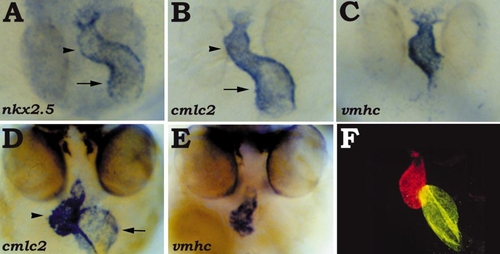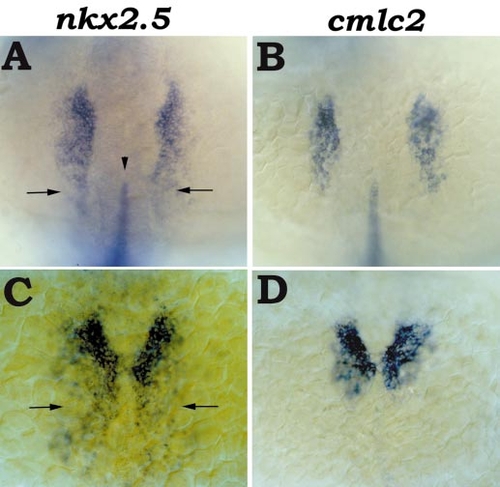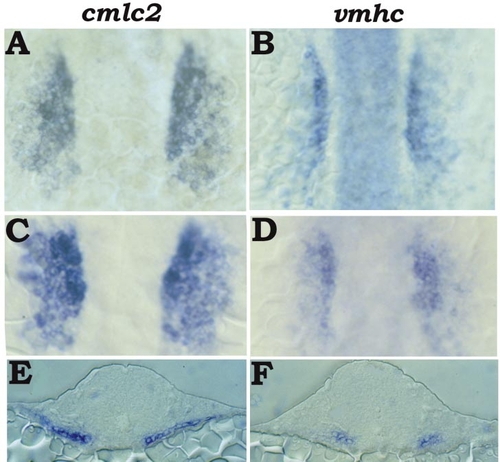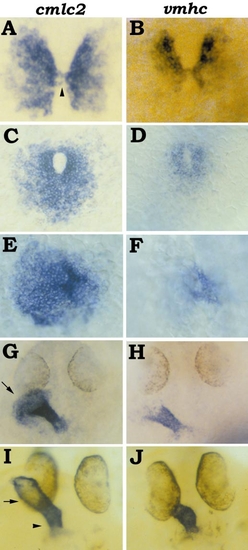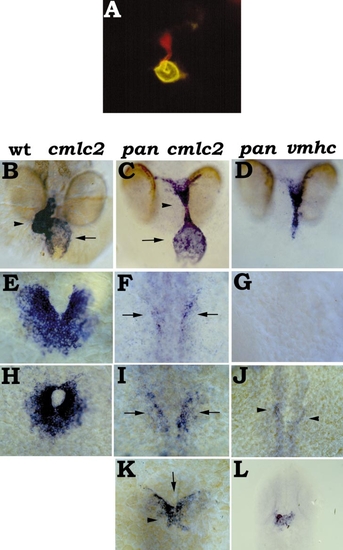- Title
-
Restricted expression of cardiac myosin genes reveals regulated aspects of heart tube assembly in zebrafish
- Authors
- Yelon, D., Horne, S.A., and Stainier, D.Y.R.
- Source
- Full text @ Dev. Biol.
|
The vmhc gene and S46 antigen are chamber-specific. (A, B, C) Dorsal views of 30-hpf embryos, anterior at the bottom; in situ hybridization showing nkx2.5 (A), cmlc2 (B), and vmhc (C) expression. While nkx2.5 (A) and cmlc2 (B) are expressed throughout both the ventricular (arrowhead) and the atrial (arrow) portions of the heart tube, vmhc (C) expression is restricted to the ventricular portion. (D, E) 48-hpf embryos viewed head-on, dorsal at the top; in situ hybridization with cmlc2 (D) and vmhc (E) riboprobes. As the yolk is gradually absorbed, the ventricle (arrowhead) becomes rostral relative to the atrium (arrow). The expression of cmlc2 (D) is maintained in both chambers, and the expression of vmhc (E) remains restricted to the ventricle. (F) Head-on view of a 48-hpf embryo stained with MF20 (TRITC) and S46 (FITC), dorsal at the top. In this double exposure, red fluorescence indicates MF20 staining of the ventricle, while yellow fluorescence indicates the overlap of S46 and MF20 staining in the atrium. |
|
cmlc2 is expressed in most, but not all, nkx2.5-expressing cells. (A, B) Dorsal views of embryos at the 14-somite stage, anterior at the top; in situ hybridization with nkx2.5 and no tail (A) or cmlc2 and no tail (B) riboprobes. no tail is expressed in the developing notochord (Schulte-Merker et al., 1994). (A) nkx2.5 expression in bilateral stripes of precardiac mesoderm extends slightly (arrows) beyond the anterior tip of the developing notochord (shown by no tail expression, arrowhead). This most posterior region has relatively weak expression of nkx2.5. (B) The posterior boundaries of the bilateral stripes of cmlc2 expression are aligned with the anterior tip of no tail expression. (C, D) Dorsal views of embryos at the 17-somite stage, anterior at the top; in situ hybridization with nkx2.5 (C) or cmlc2 (D) riboprobes. As the bilateral cardiac primordia bend toward each other, the most posterior nkx2.5-expressing cells (C, arrows) do not express cmlc2 (D). Again, these most posterior cells express relatively weak levels of nkx2.5 (C). |
|
vmhc expression is restricted to a subset of cmlc2-expressing cells. (A, C, E) Expression of cmlc2. (B, D, F) Expression of vmhc. (A, B) Dorsal views of embryos at the 15-somite stage, anterior at the top. More precardiac cells express cmlc2 (A) than vmhc (B); intentional overstaining of the embryo in (B) demonstrates that intense vmhc expression appears only in the most medial myocardial precursors. In addition to expression in precardiac cells, vmhc is also expressed in the somites (data not shown). (C, D) Dorsal views of embryos at the 16-somite stage, anterior at the top. Again, vmhc expression (D) appears restricted to the most medial cmlc2-expressing cells (C). (E, F) Transverse sections of 16-somite stage embryos also demonstrate that the vmhc-expressing cells (F) are a medial subset of the cmlc2-expressing cells (E). |
|
Following cmlc2 and vmhc expression during heart tube assembly. (A, C, E, G, I) Expression of cmlc2. (B, D, F, H, J) Expression of vmhc. All panels show dorsal views, anterior at the top. (A, B) 18-somite stage; the myocardial precursors (A) make contact via a bridge (arrowhead) of vmhc-expressing cells (B). (C, D) 21-somite stage; the cardiac cone (C) forms with vmhc-expressing cells (D) at its center and apex. (E, F) 23-somite stage; the cardiac cone (E) begins its transformation into a tube with the extension and tilting of the |
|
Achievement of cardiac A?P pattern does not require cardiac fusion. (A) Ventral view of a 48-hpf Casanova (cas) mutant embryo stained with MF20 (TRITC) and S46 (FITC), anterior at the top. Red fluorescence indicates MF20 staining of ventricular tissue (arrowheads) in the anterior portion of each lateral heart, while yellow fluorescence indicates the overlap of S46 and MF20 staining in atrial tissue (arrrows) in the posterior portion of each lateral heart. Staining of eye musculature with MF20 is also apparent just medial to each eye. (B?J) Dorsal views, anterior at the top, of wild-type and cas mutant embryos. (B, E, H) Expression of cmlc2 in wild-type embryos. (C, F, I) Expression of cmlc2 in cas mutant embryos. (D, G, J) Expression of vmhc in cas mutant embryos. (B, C, D) 18-somite stage; while cardiac fusion begins in wild-type embryos (B), the myocardial precursors in mutant embryos (C) remain stationary. vmhc-expressing cells in mutant embryos are located medially (D). (E, F, G) 21-somite stage; while the cardiac cone forms in wild-type embryos (E), myocardial precursors in mutant embryos (F) bend slightly toward the midline, led by vmhc-expressing cells (G). (H, I, J) 24 hpf; as a tube forms in wild-type embryos (H), myocardial precursors in mutant embryos (I) appear to form modified cones, with vmhc-expressing cells leading the way (J). In both wild-type (H) and mutant (I) embryos, there is an apparent condensation of preventricular tissue (arrowheads) while preatrial tissue (arrows) remains more diffuse. |
|
heart and soul (has) disrupts heart tube assembly at an intermediate stage. (A, B, C) 27-hpf embryos stained with MF20 (TRITC) and S46 (FITC), anterior to the left. Red fluorescence indicates MF20 staining of ventricular tissue, while yellow fluorescence indicates the overlap of S46 and MF20 staining in atrial tissue. (A) Lateral view of wild-type embryo. The atrium (yellow) lies posterior to the ventricle (red). (B) Lateral view of has mutant. (C) Ventral view of has mutant. The atrium (yellow) surrounds the ventricle (red). (D?L) Dorsal views, anterior at the top, of wild-type and has mutant embryos. (D, G, J) Expression of cmlc2 in wild-type embryos. (E, H, K) Expression of cmlc2 in has mutant embryos. (F, I, L) Expression of vmhc in has mutant embryos. (D, E, F) 21-somite stage; the cardiac cone has formed and has mutants are indistiguishable from their wild-type siblings. (G, H, I) 23-somite stage; while the apex of the cone has tilted in wild-type embryos (G), the cone in has mutants remains stationary (H, I). (J, K, L) 24 hpf; the has heart still retains a cone-like structure (K, L), even as formation of the wild-type heart tube is nearly complete (J). |
|
The Pandora (pan) mutation affects ventricle formation as well as early expression of cmlc2 and vmhc. (A) Head-on view of a 48-hpf pan mutant embryo stained with MF20 (TRITC) and S46 (FITC), dorsal at the top. A thin stalk of ventricular tissue (red) is attached to the rostral end of a bulbous atrium (yellow). (B, E, H) Expression of cmlc2 in wild-type embryos. (C, F, I, K) Expression of cmlc2 in pan mutant embryos. (D, G, J, L) Expression of vmhc in pan mutant embryos. (B?D) Head-on views, dorsal at the top, of 48-hpf embryos. In pan mutants, the heart is composed of a bulbous atrium (C, arrow) and a thin stalk of ventricular tissue (C, arrowhead). (E?L) Dorsal views, anterior at the top. (E, F, G) 18-somite stage; pan embryos exhibit relatively faint and thin bilateral stripes of cmlc2-expressing cells (F, arrows), in contrast to the robust cmlc2-expressing population of fusing myocardial precursors in wild-type siblings (E). pan embryos do not express vmhc at this stage (G). (H, I, J) 21-somite stage; pan embryos exhibit slightly stronger cmlc2 expression (I, arrows), but still far less than in wild-type embryos (H). Some pan embryos have faint bilateral patches of vmhc expression (J, arrowheads). (K, L) 36 hpf; cardiac cone formation is delayed and abnormal in pan mutants (K). Often, pan mutant cones have a split base (K, arrow). The apex of the pan cone (K, arrowhead) expresses a significant amount of vmhc (L). It is important to note that pan embryos lag behind their wild-type siblings during somitogenesis. For example, pan embryos usually have only 16 somites when their wild-type siblings have 20 somites. In (E?G) and (H?J), we are comparing pan embryos with wild-type embryos with the same number of somites; i.e., the wild-type siblings are fixed a few hours before the pan mutants. Also note that the precise morphology of the developing myocardium in pan mutants can vary; these examples represent typical expression patterns observed in a majority of mutants. |
Reprinted from Developmental Biology, 214(1), Yelon, D., Horne, S.A., and Stainier, D.Y.R., Restricted expression of cardiac myosin genes reveals regulated aspects of heart tube assembly in zebrafish, 23-37, Copyright (1999) with permission from Elsevier. Full text @ Dev. Biol.

